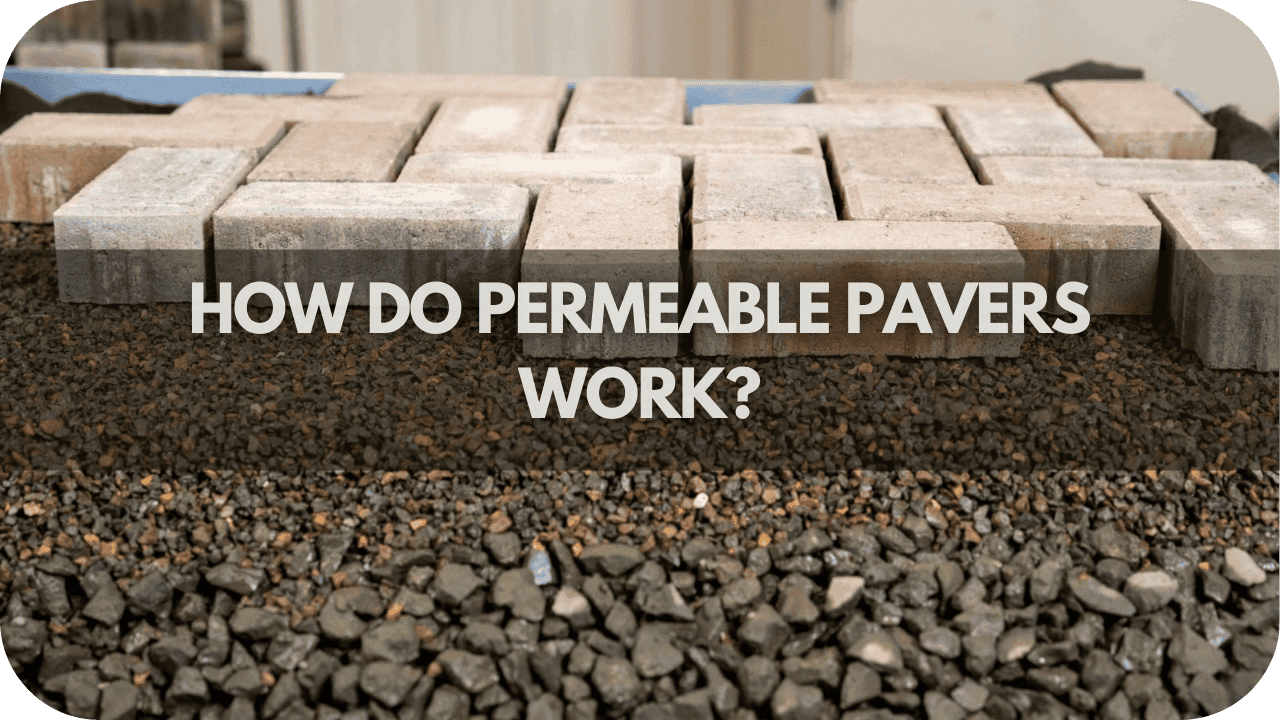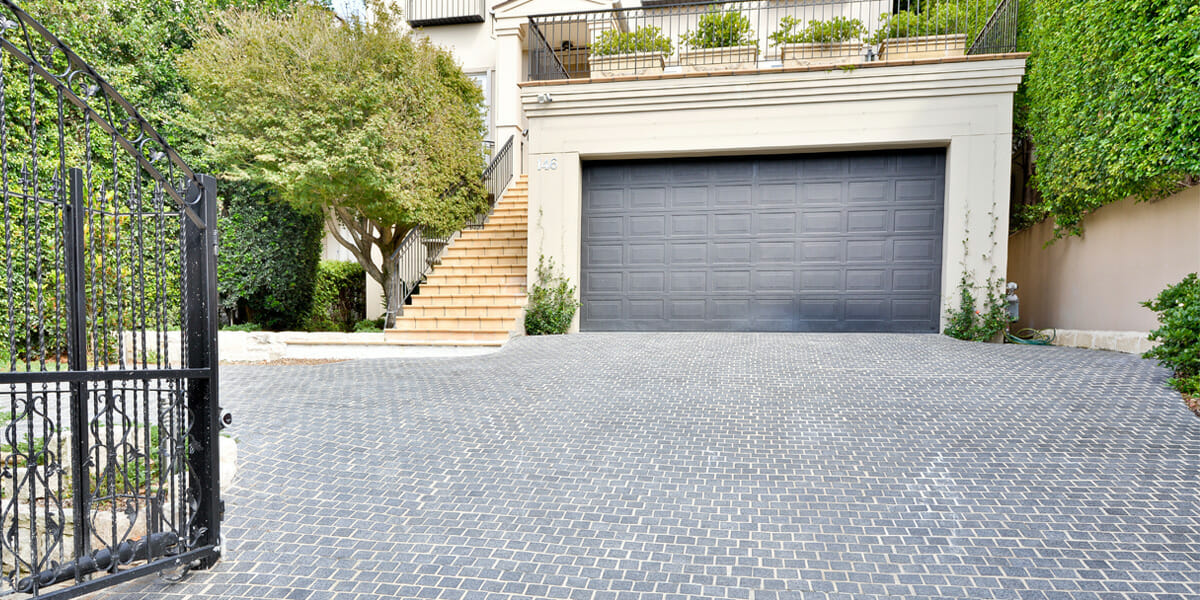
Traditional paved surfaces like concrete and asphalt prevent water from draining into the ground, leading to flooded areas and strained drainage systems. It can cause property damage, disrupt transportation, and strain the environment.
Permeable pavers offer a sustainable solution by allowing water to seep through the paved surface into the ground, mimicking the natural water absorption process.
How Do Permeable Pavers Work?
Permeable pavers work by allowing water to infiltrate through their surface and into the ground below. They are designed with gaps or porous materials that enable rainwater to pass through, reducing runoff and promoting groundwater recharge. This eco-friendly solution helps manage stormwater and prevents flooding, making it ideal for sustainable landscaping.
Functions of Permeable Pavers
Permeable pavers serve multiple critical functions, making them invaluable in modern landscaping and urban planning.
Their primary function is to manage stormwater effectively. Unlike traditional paving solutions, permeable pavers allow water to seep through their surface, reducing surface runoff and mitigating the risk of flooding. This infiltration process helps recharge groundwater supplies, ensuring a more sustainable water cycle.
Another critical function of permeable pavers is filtering pollutants. As water passes through the paver layers, contaminants such as oils, heavy metals, and sediments are trapped and filtered out, improving water quality before it re-enters the ecosystem.
This natural filtration process is crucial for maintaining clean waterways and supporting local biodiversity.
Additionally, permeable pavers contribute to reducing the urban heat island effect. Allowing water to permeate and evaporate helps cool the surrounding area, making urban environments more comfortable and reducing the need for artificial cooling solutions.
Benefits of Permeable Pavers
Permeable pavers offer a range of advantages, from stormwater management to ecological enhancement. Discover how these innovative paving solutions can transform your construction projects.
- Stormwater Management: Permeable pavers allow water to infiltrate through the surface, reducing the risk of flooding and erosion. This eco-friendly solution helps replenish groundwater, contributing to sustainable water management.
- Water Quality Improvement: Permeable pavers enhance water quality by filtering pollutants and contaminants from rainwater as they percolate through the surface layers. This feature is precious in urban environments where impervious surfaces exacerbate water pollution issues.
- Cost-effectiveness: These pavers’ porous nature reduces the need for conventional drainage systems, saving on installation and maintenance costs over time.
- Safety Enhancement: Permeable pavers minimise surface water accumulation, reducing the risk of accidents caused by slippery surfaces, thus enhancing safety.
- Ecological Enhancement: Permeable pavers promote biodiversity by facilitating soil aeration and moisture retention, fostering healthier conditions for vegetation growth.
- Durability: Permeable pavers are typically durable and can withstand heavy loads, making them suitable for various traffic conditions, including pedestrian walkways, driveways, and parking lots.
- Versatility: These pavers come in various shapes, sizes, and colours, offering flexibility in design and allowing for creative landscaping solutions.
- Aesthetic Appeal: Permeable pavers can enhance the aesthetic appeal of outdoor spaces by providing a visually pleasing alternative to traditional pavement materials.
Applications of Permeable Pavers
Discover the myriad applications of permeable pavers, from urban landscaping to residential surfaces and commercial developments. Explore how these versatile paving solutions can transform various settings while effectively addressing stormwater management needs.
Builders extensively use permeable pavers for sidewalks, pedestrian plazas, and streetscapes in urban landscaping. Their ability to allow water infiltration helps manage stormwater runoff, reducing flooding risks and alleviating strain on drainage systems.
Additionally, permeable pavers lessen the urban heat island effect by promoting natural cooling through water evaporation.
Permeable pavers are prevalent in driveways, patios, and pathways in residential settings. They prevent surface water accumulation, enhancing safety by reducing the risk of slippery surfaces.
Homeowners appreciate their aesthetic appeal and the variety of design options available, which can complement any architectural style.
Furthermore, permeable pavers help maintain healthy lawns and gardens by ensuring adequate water penetration to the soil, supporting plant growth, and reducing erosion.
Most employ permeable pavers in parking lots, loading areas, and outdoor recreational spaces in commercial and industrial areas. Their durability and stormwater management capabilities make them ideal for high-traffic areas, ensuring long-lasting performance while promoting environmental sustainability.
Businesses benefit from reduced maintenance costs associated with traditional drainage systems, and the enhanced aesthetic appeal can improve customer and employee satisfaction.
Moreover, using permeable pavers can contribute to achieving green building certifications, such as LEED (Leadership in Energy and Environmental Design), which recognises sustainable construction and design efforts.
Installation Process of Permeable Pavers
Discover the meticulous steps in installing permeable pavers, from excavation to compaction, ensuring a stable and effective stormwater management system.
Step 1: Excavation
The installation process begins with excavation. You should excavate the area designated for the permeable pavers to a 6 to 12-inch depth, adjusting it based on the project’s specific requirements and soil characteristics.
Excavation ensures enough space to accommodate the base material layers needed for proper drainage and stability.
Step 2: Base Layer
Once the excavation is complete, a base layer of aggregate material, typically crushed stone or gravel, is spread and compacted within the excavated area. The base layer serves several essential functions.
First, it provides a stable foundation for the pavers, ensuring they remain level and do not shift over time. Additionally, the base layer acts as a reservoir for stormwater, allowing excess water to drain away from the surface.
Step 3: Bedding Sand
After the base layer is in place, a layer of bedding sand is evenly distributed over the compacted aggregate base. The bedding sand provides a smooth and level surface for laying the pavers.
It also helps to cushion the pavers and distribute weight evenly across the surface. Properly levelled bedding sand is crucial for achieving a uniform finished surface and preventing any irregularities or dips in the pavement.
Step 4: Paver Installation
Carefully place each paver to ensure a tight fit and cohesive surface. Interlocking pavers are often used for permeable pavement systems, as they provide additional stability and prevent shifting. Lay the pavers in the desired pattern, with small gaps left between them to allow water to permeate through.
Step 5: Joint Sand
After installing the pavers, sweep additional joint sand over the surface to fill the gaps between them. This joint sand helps to lock the pavers in place and prevent them from shifting or becoming loose.
It also helps to promote proper drainage by allowing water to flow freely between the pavers and into the underlying base layers.
Step 6: Compaction
Finally, the entire surface is compacted using a mechanical compactor. This compaction process helps to secure the pavers further and ensure they are firmly seated on the base layers below.
Compaction also helps to eliminate any air pockets or voids within the pavement, improving overall stability and durability.
Maintenance of Permeable Pavers
Maintaining permeable pavers is essential for preserving their functionality and longevity. Regular maintenance tasks include periodic surface cleaning through sweeping or pressure washing to remove debris and prevent clogging of pores, ensuring permeability.
Weed control is necessary, and it involves removing weeds by hand or using eco-friendly herbicides to prevent vegetation from obstructing water flow. Moss and weeds can often grow between the gaps of pavers, especially in damp or shaded areas. Regularly addressing these issues keeps the pavers clean and ensures proper water flow.
Joint refilling with fresh sand helps maintain the pavers’ stability and interlocking, which may erode over time.
Regular surface inspections identify any damage or irregularities, allowing for prompt repairs to prevent further deterioration. Periodically resealing the pavers protects them from stains and enhances their durability, especially in high-traffic areas.
Checking and levelling the surface ensures proper water drainage and prevents uneven settling, which can affect permeability.
During winter, removing snow and ice promptly using plastic shovels or snow blowers prevents damage and maintains accessibility. Additionally, monitoring nearby trees and managing root growth helps avoid damage to the paver surface and underlying layers.
Conclusion
Permeable pavers offer a sustainable solution for managing stormwater, enhancing urban landscapes, and promoting ecological balance.
Their ability to mitigate flooding, improve water quality, and reduce environmental impact underscores their importance in sustainable landscaping. Embrace permeable pavers for a greener, more resilient future.
More To Explore

Grey Granite Cobblestones for Driveways: Strength and Style
Grey granite cobblestones combine strength, safety, and timeless appeal, making them a popular choice for Melbourne driveways and outdoor spaces. Their natural flamed texture offers

Granite Wall Cladding Melbourne: Modern and Classic Appeal
Granite wall cladding brings both modern sophistication and classic charm to Melbourne architecture. Known for its durability and natural beauty, granite transforms façades, feature walls,


